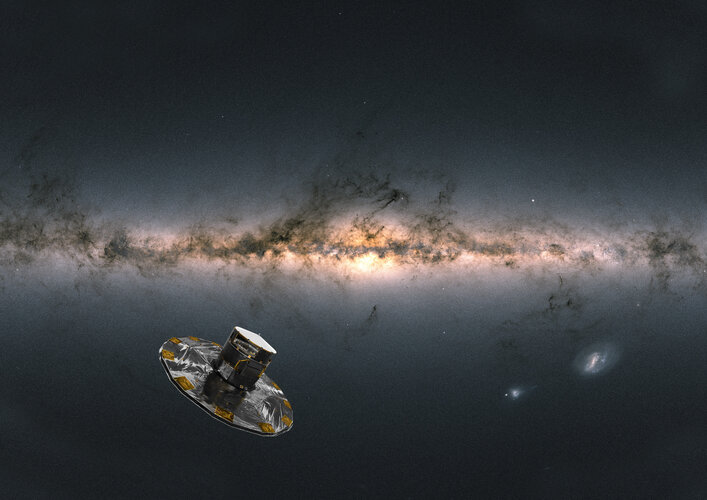Refining our galaxy’s shape
Gaia has clarified the appearance of our galaxy, providing a more accurate view of its shape and symmetry – or lack of it.
The Milky Way is a spiral galaxy with a central ‘bar’ of stars cutting through its core, multiple spiral arms, and a more diffuse halo extending outwards. This halo was assumed to be generally spherical and homogeneous, like a beach ball. However, Gaia has shown that the Milky Way’s halo instead looks elongated, tilted and stretched, like a rugby ball that has just been kicked.
Gaia scientists have also mapped the general structure of the Milky Way’s central bar and swirling spiral arms, refining our understanding of their length, tilt and asymmetry.
Additionally, we’ve known since the 1950s that the Milky Way’s disc is warped and asymmetrical, but we were unsure of why. Gaia has revealed that this warping is caused by an ongoing collision with another smaller galaxy – likely the Sagittarius dwarf galaxy, which has smashed through our galaxy’s disc three times in the past. Sagittarius has been orbiting our galaxy for 4-5 billion years, and is slowly being ripped apart in the course of an ongoing merger.
These collisions have sent disruptive waves and ripples spreading through the Milky Way like a stone thrown into water, causing the galaxy to warp and wobble. They may have been the trigger that caused the Sun and Solar System to form: another result from Gaia. According to Gaia, the ripples caused by the influence of Sagittarius prompted multiple bursts of new star formation, one of which aligns in time with when we believe the Sun to have formed some 4.6 billion years ago.
Gaia has shown that the Milky Way is still enduring some of the ripples caused by a near-miss collision with Sagittarius, which caused stars within the galaxy’s disc to move in distinct patterns. For some stars, Gaia measures not only their position in space but also their full movements in three dimensions. In these data, researchers have identified a never-before-seen pattern that looks a little like a snail’s shell. Further study led to the conclusion that the stars ‘remembered’ being perturbed by Sagittarius in the past, and still show signs of this in their ongoing motions.



